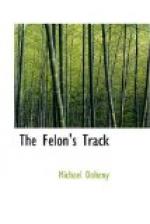GREY, EARL (1802-1894).—Third Earl. Colonial Secretary in the British Liberal Government, 1846 to 1852.
HALPIN, THOMAS M.—Secretary of the Confederation, and a Dublin working-man. According to Meagher he failed to transmit instructions to the Dublin Confederate Clubs to rise in insurrection in the streets of the capital when the fight opened in Tipperary. Halpin denied emphatically having received such orders. After the insurrection he made his way to the United States.
HEYTESBURY, LORD (1779-1860).—William A’Court, British Envoy in Spain and Naples, and Ambassador in Portugal and Russia. Lord Lieutenant of Ireland, 1844-6.
HOGAN, JOHN (1800-1858).—One of the greatest of modern sculptors. With MacManus and other artists he presented O’Connell with the “Repeal Cap,” modelled on the Irish Crown.
HOLLYWOOD, EDWARD.—A silk-weaver and, with Michael Crean, an artisan leader. He acted as treasurer of the Davis Confederate Club. Arrested in Wicklow with D’Arcy M’Gee for sedition, but the prosecution was abandoned. After the insurrection he escaped to France, and some years later returned to Dublin.
HOLMES, ROBERT (1765-1859).—Brother-in-law of Thomas Addis and Robert Emmet, and a vehement opponent of the Union in 1799-1800. He declined to accept promotion at the Bar while the Union endured.
HUDSON, WILLIAM ELIOT (1797-1853).—Described by Thomas Davis as the best man and the best Irishman he ever knew. A man of fortune and culture who devoted his leisure and his wealth to helping every movement for the betterment of Ireland.
HUME, JOSEPH (1777-1855).—An English politician who sat in the British Parliament for English, Irish, and Scotch constituencies as Tory and later as Radical. Chief author of the Radical shibboleth, “Peace, Retrenchment and Reform.”
IRELAND, RICHARD.—A barrister, one of the founders of the Protestant Repeal Association in 1848. He emigrated to Australia afterwards and became Attorney-General of Victoria.
KENYON, FATHER (18— -1869).—Curate and afterwards Parish Priest of Templederry in Tipperary. A strong opponent of the “Old Irelanders” and the close political and personal friend of John Mitchel.
LALOR, JAMES FINTAN (1810-49).—Son of Patrick Lalor, M.P. of Queen’s Co. A vigorous writer whose agrarian doctrine was converted by Henry George into Land Nationalisation—which it was not. He contributed to the Nation and the Felon, 1847-8, and attempted an insurrectionary conspiracy, 1849.
LAMARTINE, ALPHONSE DE (1790-1869).—Minister for Foreign Affairs in the French Republican Government. The British Ministry through Lord Normanby threatened him with the possible rupture of diplomatic relations if he gave an encouraging reply to the Young Ireland deputation. Politically Lamartine was more of the school of the British Whigs of his period than of any native French school. His high character and literary abilities were held in deserved esteem by his countrymen, but as a man of affairs he was never really successful.




